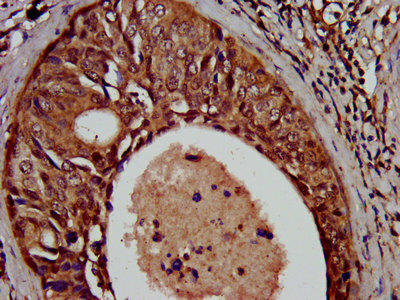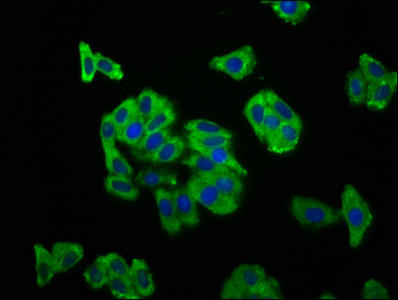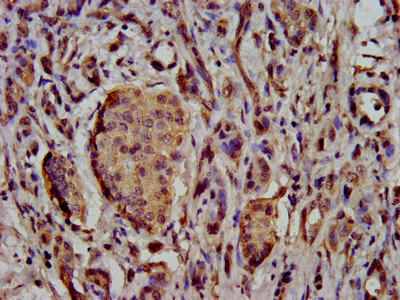Description
| Antibody Name: | SCN11A Antibody (PACO58568) |
| Antibody SKU: | PACO58568 |
| Size: | 50ug |
| Host Species: | Rabbit |
| Tested Applications: | ELISA, IHC, IF |
| Recommended Dilutions: | ELISA:1:2000-1:10000, IHC:1:500-1:1000, IF:1:50-1:200 |
| Species Reactivity: | Human |
| Immunogen: | Recombinant Human Sodium channel protein type 11 subunit α protein (403-551AA) |
| Form: | Liquid |
| Storage Buffer: | Preservative: 0.03% Proclin 300 Constituents: 50% Glycerol, 0.01M PBS, pH 7.4 |
| Purification Method: | >95%, Protein G purified |
| Clonality: | Polyclonal |
| Isotype: | IgG |
| Conjugate: | Non-conjugated |
 | IHC image of PACO58568 diluted at 1:500 and staining in paraffin-embedded human cervical cancer performed on a Leica BondTM system. After dewaxing and hydration, antigen retrieval was mediated by high pressure in a citrate buffer (pH 6.0). Section was blocked with 10% normal goat serum 30min at RT. Then primary antibody (1% BSA) was incubated at 4°C overnight. The primary is detected by a biotinylated secondary antibody and visualized using an HRP conjugated SP system. |
 | Immunofluorescence staining of HepG2 cells with PACO58568 at 1:166, counter-stained with DAPI. The cells were fixed in 4% formaldehyde, permeabilized using 0.2% Triton X-100 and blocked in 10% normal Goat Serum. The cells were then incubated with the antibody overnight at 4°C. The secondary antibody was Alexa Fluor 488-congugated AffiniPure Goat Anti-Rabbit IgG(H+L). |
 | IHC image of PACO58568 diluted at 1:500 and staining in paraffin-embedded human pancreatic cancer performed on a Leica BondTM system. After dewaxing and hydration, antigen retrieval was mediated by high pressure in a citrate buffer (pH 6.0). Section was blocked with 10% normal goat serum 30min at RT. Then primary antibody (1% BSA) was incubated at 4°C overnight. The primary is detected by a biotinylated secondary antibody and visualized using an HRP conjugated SP system. |
| Background: | This protein mediates the voltage-dependent sodium ion permeability of excitable membranes. Assuming opened or closed conformations in response to the voltage difference across the membrane, the protein forms a sodium-selective channel through which sodium ions may pass in accordance with their electrochemical gradient. It is a tetrodotoxin-resistant sodium channel isoform. Also involved, with the contribution of the receptor tyrosine kinase NTRK2, in rapid BDNF-evoked neuronal depolarization. |
| Synonyms: | Sodium channel protein type 11 subunit α (Peripheral nerve sodium channel 5) (PN5) (Sensory neuron sodium channel 2) (Sodium channel protein type XI subunit alpha) (Voltage-gated sodium channel subunit α Nav1.9) (hNaN), SCN11A, SCN12A SNS2 |
| UniProt Protein Function: | Function: This protein mediates the voltage-dependent sodium ion permeability of excitable membranes. Assuming opened or closed conformations in response to the voltage difference across the membrane, the protein forms a sodium-selective channel through which sodium ions may pass in accordance with their electrochemical gradient. It is a tetrodotoxin-resistant sodium channel isoform. Also involved, with the contribution of the receptor tyrosine kinase NTRK2, in rapid BDNF-evoked neuronal depolarization. Ref.1 Ref.3 |
| UniProt Protein Details: | Subunit structure: The voltage-resistant sodium channel consists of an ion conducting pore forming alpha-subunit regulated by one or more auxiliary subunits SCN1B, SCN2B and SCN3B. Subcellular location: Membrane; Multi-pass membrane protein By similarity. Tissue specificity: Expressed in the dorsal root ganglia and trigeminal ganglia, olfactory bulb, hippocampus, cerebellar cortex, spinal cord, spleen, small intestine and placenta. Ref.2 Ref.5 Domain: The sequence contains 4 internal repeats, each with 5 hydrophobic segments (S1,S2,S3,S5,S6) and one positively charged segment (S4). Segments S4 are probably the voltage-sensors and are characterized by a series of positively charged amino acids at every third position. Post-translational modification: Phosphorylation at Ser-1341 by PKC in a highly conserved cytoplasmic loop slows inactivation of the sodium channel and reduces peak sodium currents By similarity. Sequence similarities: Belongs to the sodium channel (TC 1.A.1.10) family. Nav1.9/SCN11A subfamily. [View classification] |
| NCBI Summary: | This proto-oncogene, highly-expressed in a variety of tumor cell lines, belongs to the sevenless subfamily of tyrosine kinase insulin receptor genes. The protein encoded by this gene is a type I integral membrane protein with tyrosine kinase activity. The protein may function as a growth or differentiation factor receptor. [provided by RefSeq, Jul 2008] |
| UniProt Code: | Q9UI33 |
| NCBI GenInfo Identifier: | 19924165 |
| NCBI Gene ID: | 6098 |
| NCBI Accession: | NP_002935.2 |
| UniProt Secondary Accession: | Q9UI33,Q15368, Q5TDB5, |
| UniProt Related Accession: | P08922 |
| Molecular Weight: | 263,915 Da |
| NCBI Full Name: | proto-oncogene tyrosine-protein kinase ROS |
| NCBI Synonym Full Names: | ROS proto-oncogene 1, receptor tyrosine kinase |
| NCBI Official Symbol: | ROS1 |
| NCBI Official Synonym Symbols: | ROS; MCF3; c-ros-1 |
| NCBI Protein Information: | proto-oncogene tyrosine-protein kinase ROS |
| UniProt Protein Name: | Sodium channel protein type 11 subunit alpha |
| UniProt Synonym Protein Names: | Peripheral nerve sodium channel 5; PN5; Sensory neuron sodium channel 2; Sodium channel protein type XI subunit alpha; Voltage-gated sodium channel subunit alpha Nav1.9; hNaN |
| Protein Family: | Protein |
| UniProt Gene Name: | SCN11A |
| UniProt Entry Name: | SCNBA_HUMAN |






